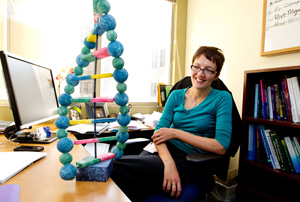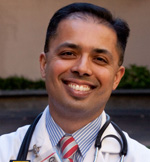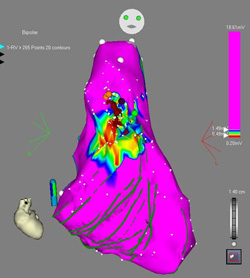January 9, 2012 - By John Sanford

Colleen Caleshu, a genetic counselor at the Stanford Center for Inherited Cardiovascular Disease, helps patients and their families understand and cope with the ramifications of inherited conditions.
We inherit our parents’ DNA, which has its upsides and downsides. Lauren Sassoubre discovered one of the downsides after being rushed to the emergency department at Stanford Hospital & Clinics with severe heart palpitations.
In the past, the cause of Sassoubre’s problem might have remained a mystery, but advances in cardiology and genetics helped her doctors make a definitive diagnosis relatively quickly: The 30-year-old PhD candidate in civil and environmental engineering at Stanford University had arrhythmogenic right ventricular cardiomyopathy, an inherited condition that causes abnormally fast heart rhythms that can lead to cardiac arrest.
The condition not only posed an immediate threat to Sassoubre’s health, but also presented another dilemma: It meant that others in her family might carry the mutation and not know it. Only two days before Sassoubre landed in the hospital, her older sister discovered she was pregnant, meaning that, if she also carried the mutation, it could be passed on to her baby.
While ARVC can be managed with medication, lifestyle changes and other therapies, it has routinely gone undiagnosed until after a patient’s death. There are often no symptoms until young adulthood. In recent years, however, an explosion of medical research into the genetics of inherited heart disorders and advances in DNA-sequencing technology have made it and other inheritable cardiac disorders much easier to diagnose. “Practically every week we learn more about how gene mutations underpin certain heart conditions,” said Euan Ashley, MD, DPhil, director of the Stanford Center for Inherited Cardiovascular Disease. “Meanwhile, technologies in genetics are bringing us toward a world of more individualized, or personalized, medicine.”
The center, which opened last year, is one of a select group of medical establishments worldwide that focuses on diagnosing and treating genetic heart disorders. Today, dozens of genes and thousands of different mutations in those genes have been linked to genetic heart diseases, such as hypertrophic cardiomyopathy (a thickening of the heart muscle) and long QT syndrome (a heart-rhythm disorder). The center offers diagnostic and treatment services for such disorders and genetic counseling that enables patients and their families to better cope with them.
ARVC, for instance, is known to be associated with mutations in any one of several genes, as Colleen Caleshu, MS, a genetic counselor at the new Stanford center explained to Sassoubre not long after her visit to the hospital.
“I was relieved to be able to talk with her,” Sassoubre said. “It was just really nice — reassuring — to get more information. Reassuring to have someone I could call or email if I had some sort of question related to family trees and genetic testing.”
Secrets of the heart
For her doctoral research, Sassoubre studies pathogens in coastal waters. On April 7, she was walking with some water samples to a laboratory on the Stanford campus when she began to feel her heart race. She had experienced such palpitations before — when jogging or walking her dog, for example — but never considered them serious; they would generally diminish within a few hours. In this instance, however, her heart continued to beat fast for the rest of the day and through the night. The following morning, her husband drove her to Vaden Health Center, a clinic for Stanford students, where her pulse was measured at upwards of 200 beats per minute. She was taken to Stanford Hospital.
Mintu Turakhia, MD, MAS, a cardiac electrophysiologist at the hospital and instructor at the School of Medicine, was one of the first physicians to treat Sassoubre after she was transferred from the emergency department to the cardiovascular intensive care unit. An electrocardiogram revealed that she was suffering from ventricular tachycardia, a type of abnormally fast heart rate.
“Approximately 95 percent of people who have the ECG pattern that Ms. Sassoubre had would be considered to have a structurally normal heart, not ARVC,” Turakhia said. Nevertheless, he suspected that she was the rare exception. For one, he said he did not think this type of arrhythmia could sustain itself, uninterrupted, for as long as it did in her case.

Mintu Turakhia
Turakhia and his team performed a series of non-invasive heart tests to help make a diagnosis, but the results were inconclusive. “It would have been easy to walk away and inform Lauren that her heart is fine,” Turakhia said. “However, I wasn’t convinced.”
He decided to go one step further and conduct an electrophysiological study that is not typically used in diagnosing ARVC. He and his colleagues carefully threaded several catheters with electrodes into her heart from blood vessels in her leg to create a three-dimensional map of the electrical voltage in her heart. Then, they induced the tachycardia. Results of the study pointed to evidence of scar tissue consistent with ARVC in her right ventricle.
“Patients with a more benign form of tachycardia don’t have this kind of scarring,” said Marco Perez, MD, an instructor in cardiovascular medicine at the School of Medicine and member of the Center for Inherited Cardiovascular Disease. “Although not definitive, this finding pointed to ARVC as the most likely diagnosis.”
Sassoubre had a defibrillator implanted in her chest that could sense when she had ventricular tachycardia and deliver pulses of electricity to terminate the abnormal rhythm. It could even deliver a shock to resuscitate the heart in the unlikely event of cardiac arrest. She also underwent a procedure in which a catheter was used to destroy some of the problem-causing heart tissue. Since then, she has been taking medication to help suppress the abnormal rhythms.
But even after leaving the hospital, the diagnosis had a major impact on how Sassoubre would lead her life, and it would also have implications for her extended family. It was important to know for sure she had inherited ARVC, and the center offered a tool that could potentially provide that certainty: a genetic test, in which DNA is extracted from a blood sample and then analyzed using a sequencing machine. When the findings came back a couple of months later, they confirmed Turakhia’s early suspicions. “This is now proof positive,” he said.
Genetic counseling

In an electroanatomic voltage map of the patient’s heart the purple area represents healthy tissue, and the colored areas indicate parts of the heart with low voltage due to the disease.
Sassoubre had a mutation of the PKP2 gene, which normally makes a protein called plakophilin-2 found in heart muscle. In her case, however, the faulty protein was not doing what it should; instead, it was causing the buildup of a fatty, scarlike tissue in the organ wall. This tissue disrupted the electrical signal controlling her heartbeat.
ARVC is thought to occur in one of every 2,000 to 5,000 U.S. adults, although the exact risk is unknown. It can be aggravated by exercise.
To learn more about the ramifications of the diagnosis, Sassoubre and some of her family members met with the genetic counselor, Caleshu, who joined Stanford last year with the launch of the Center for Inherited Cardiovascular Disease.
“What we do as genetic counselors is help patients understand and adapt to the hereditary conditions in their family,” said Caleshu, who is also a clinical assistant professor of genetics. “We help them navigate choices about family planning and even about whether they want to know predictive information about their health.”
Caleshu, who earned a master’s degree in genetic counseling from Johns Hopkins University and the National Human Genome Research Institute, specializes in inherited heart diseases and is one of only a handful of such counselors with this particular expertise in California.
As a geneticist, Caleshu is trained to interpret the often subtle but significant implications of abnormal genetic markers. There are many unique gene variations and mutations among humans, so DNA test results require a close reading to avoid false positives or negatives, she said. After she gets results back from a lab, she analyzes them in light of her own expertise in cardiac genetics and also consults peer-reviewed studies of the disease and of the possible gene mutations involved. “Genetic test results are probabilistic, never black and white,” she added. “Reading them often feels more like art than science.”
Caleshu reviewed Sassoubre’s family and medical histories and explained to her how the gene mutation was passed down; provided information to help her make decisions around family planning; and crafted a letter explaining the condition for distribution to her family members.
Her sister, Ticien Sassoubre, PhD, a lecturer at Stanford Law School who was expecting her first child, also chose to meet with Caleshu. “It was a great opportunity to talk through what it all means,” Ticien said.
“It’s very confusing, right?” she continued. “To figure out, OK, what does autosomal dominant mean? What does penetrance mean? In terms of penetrance, what is the chance that if I have the mutation I will develop the disease? How worried should we be? It’s really great to have someone like Colleen to answer these questions. She helps you to process this information.”
The sisters’ father tested positive for the PKP2 gene mutation. Their mother’s results were negative. Ticien Sassoubre also tested negative for the mutation, and her baby was born Dec. 18. It’s a girl.
For more information about the Center for Inherited Cardiovascular Disease, visit the web at http://familyheart.stanford.edu. To schedule an appointment, call (650) 721-4363.
John Sanford is a writer in the communications office for Stanford Hospital & Clinics.
About Stanford Medicine
Stanford Medicine is an integrated academic health system comprising the Stanford School of Medicine and adult and pediatric health care delivery systems. Together, they harness the full potential of biomedicine through collaborative research, education and clinical care for patients. For more information, please visit med.stanford.edu.